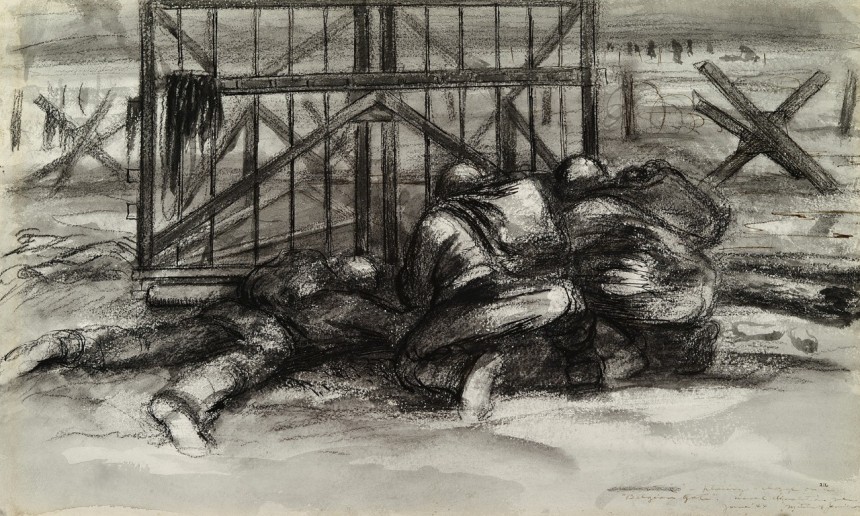Combat Gallery Sunday: Opening Up the Beach edition
Much as once a week I like to take time off to cover warships (Wednesdays), on Sundays (when I feel like working), I like to cover military art and the painters, illustrators, sculptors, photographers and the like that produced them.
Combat Gallery Sunday: Opening Up the Beach edition
U.S. Army combat artist/infantryman Mitchell Jamieson, who we covered on our 75th Anniversary of D-Day post, spent a week after landing at Normandy on Day 1 with the men of the U.S. Navy’s 6th Beach Battalion, the precursor to today’s Beachmaster Units, as they worked on Omaha.
Writer A.J. Liebling described the 6th as “sailors dressed like soldiers, except that they wore black jerseys under their field jackets; among them were a medical unit and a hydrographic unit. The engineers included an M.P. detachment, a chemical-warfare unit, and some demolition men. A beach battalion is a part of the Navy that goes ashore; amphibious engineers are part of the Army that seldom has its feet dry.”

[ORIGINAL CAPTION] INVASION … Carrying full equipment, American assault troops move onto a beachhead on the northern coast of France. Landing craft, in the background, jams the harbor. June 6, 1944. Omaha Beach. [If you note, he is a Navy man and has the same Beach Company markings on his helmets as above.] National Archives # 111-SC-189902.
Jamieson chronicled them well.
Placing a Charge on a “Belgian Gate”
“Naval demolition men are preparing a charge that will blow up this “Belgian Gate” type of obstacles, which is a framework of steel mounted on rollers, with the flat side facing seaward, about 10′ high and 8’wide. The explosive charge used for this type of obstacle was very pliable and could be bent around steel or stuffed in crevices. Tetrytol, a stronger charge, but not easily handled was also used.
These demolition units were started as part of the beach battalions and were trained intensively for this type of work. After they cleared channels through the barriers and the beach was secured, their most important job was over, but there still remained plenty of demolition work to do on the beach.”
Naval Demolition Men Blowing Up Obstacles
“Another beach obstacle was the log ramp. This was nine to ten feet high, consisting of two upright logs driven into the sand, one short and one long, with a third log placed on top slanting backward from the sea. This was constructed to catch an incoming landing craft and slide it upward towards the mine placed on the end. Stakes pointing seaward with mines attached were a variation of this, but perhaps the most commonly used obstacle was the hedgehog or tetrahedron or “element C” as it was variously called. This was an ingenious contrivance of three steel rails, riveted together and flattened on their ends to prevent sinking too far into the sand. All these devices were used in combination, usually with “Belgian Gates” and log ramps, forming an outer barrier with hedgehogs and stakes thickly placed inside all along the beach. Some of the beaches were found to be much more formidable in barriers than others.”
Old Campaigners (Cold and Wet)
“These are men of the U.S. Navy’s 6th Beach Battalion in the Omaha sector. The terrible, confusing experience of the landing and the first two days on the beach had by now turned into a routine pattern of hard work, sleeplessness and the kind of living conditions generally described as “rugged.” The men already had the look of old campaigners, each adapting himself in his own way to his surroundings. Beach battalion losses were heavy here. They hit the shore with the first waves, but in this sector where resistance was so fierce, the work of organizing the unloading was virtually impossible until it was secured to some degree. The sign in the background pointed to one of the exits from the beach, which was just to the right of the picture. The men live in foxholes between here and the water’s edge.”
Many of Jameison’s paintings are in museums across the country, to include the Smithsonian.




I am sure that you just copied the caption on the original source of the photograph but there is an error.
This flag represents the numeral 0. Baker is an all red flag. Bravo is the word that is currently used to designate the letter B when the letter needs to be spoken out loud.
See “https://www.etsy.com/listing/239907665/international-maritime-signal-flags-and”
Also see Wikipedia for the various names for the letters in the 20th century under the topic – “Allied military phonetic spelling alphabets”
https://en.wikipedia.org/wiki/Allied_military_phonetic_spelling_alphabets
Whelp, that is what the exhibit at the SEAL Museum said and one of the curators vouched for when I was there. I took the image. Thanks for pointing it out that it was not the traditional baker phonetic. I deleted it.
I know boy/baker/bravo is a red pennant with twin tails but haven’t seen a reference to the five-clubbed flag in the display other than the “zero” (Guard/mail) flag so I rolled with what the museum had said.
https://www.navsource.org/archives/05/helpers/sfpa.htm